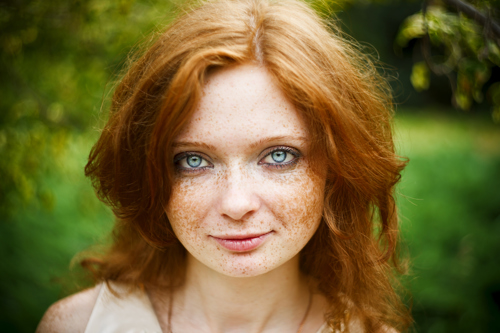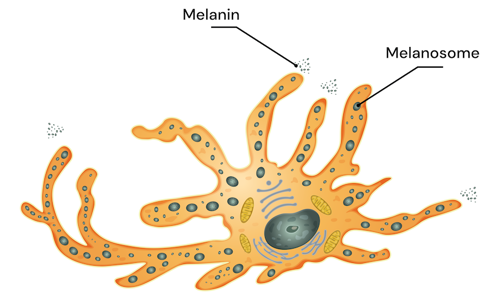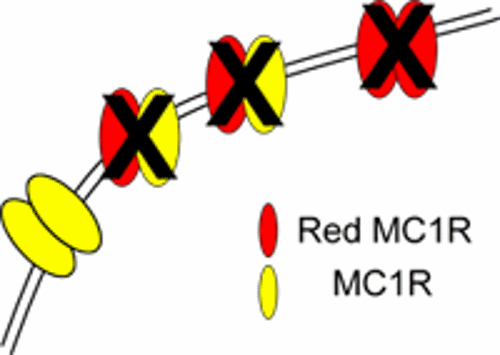
Can a recessive trait become dominant?
February 2, 2012

- Related Topics:
- Dominant and recessive,
- Pigmentation traits,
- Red hair,
- Rare events,
- Complex traits
A high school student from Canada asks:
"Can a recessive trait become dominant?"
Surprisingly, yes. I can't think of any examples off the top of my head but it is definitely theoretically possible for a recessive trait to become dominant.
Now to clarify, I don't mean “common”. As we talk about here, “dominant” and “common” are not the same thing. It is possible for recessive traits to be the most common (think blue eyes in Sweden) or dominant traits to be rare (like having extra fingers).
What makes a trait recessive has to do with the particular DNA difference that leads to that trait. So one way a trait can go from recessive to dominant is with a new DNA difference that is dominant and causes the same trait. This is what I'll focus on for the rest of the answer.
In particular, I'll take you through an example of how red hair might go from being a recessive trait to a dominant one. But before we can do that, we need to take a step back and do a quick review of genes and how they work.

"Red Hair" Gene
Our traits come from the genes contained in our DNA. So there is a gene that tells our eyes whether or not to be blue. And another that tells us if a certain chemical in broccoli tastes bitter or not. Or one that tells our hair whether or not to be red. And so on.
We have two copies of most of our genes – one from our mother and one from our father. The trait we end up with depends on the particular combination of copies we inherited.
For example, the decision on whether or not to have red hair comes from the MC1R gene. This gene comes in two different versions, red and not-red.
You only have red hair if you get a red copy from both mom and dad. This is why red hair is recessive. A single copy of the not-red version trumps the red one. So having only one red copy isn’t enough to have red hair.
This tells us red hair is recessive but doesn't really give us the explanation of why. For that, we need to start talking about proteins.
"Red Hair" Protein
Each gene is actually the recipe for a particular protein. It is this protein that goes out and does a job in the body that leads to a particular trait.
Different versions of genes make slightly different proteins. These different proteins each do their job a bit differently.
The MC1R gene has the instructions for the MC1R protein. This protein has many jobs but we are just going to focus on one – its ability to change red pigment into brown.
The not-red versions of the MC1R protein can do this job perfectly well. They are busy in most of us right now, changing red pigment into brown.
This is why most people don't have red hair. All their red pigment is changed into brown before it can color their hair red.
It is a different story for redheads. Their MC1R protein can't do this job very well at all. The end result is a build up of red pigment and so, red hair.

Recessive Red
A key to understanding why red hair is recessive is that it doesn't take a lot of working MC1R protein to turn red pigment into brown. One copy's worth is usually plenty.
This is why people with one red and one not-red version of the MC1R gene don't have red hair. They still make enough working MC1R protein from their not-red copy to convert all of their red pigment into brown.
This is the underlying reason why red hair is a recessive trait. The DNA differences in the red version affect only that copy of the MC1R gene. The other copy can independently make enough working protein to do its job and keep red hair at bay.
Because of how red hair versions of the MC1R gene work, they can't simply become dominant. To get dominant red hair, we'll need a new DNA difference. One that makes a protein that both doesn't work AND shuts off any working MC1R protein lying around.
Now if you had just one copy of this new gene version, you'd have red hair. Because there wouldn't be any MC1R protein available to change red pigment into brown.
Phew! That was not easy. I hope that it made sense. At the very least I hope it is clear that we need a new DNA difference that can lead to red hair. There isn't any obvious way to repurpose our old red MC1R gene version into a dominant one.
In the final section, I want to tackle one possible DNA difference in the MC1R gene that might give us a dominant gene version. But before doing that, I want to emphasize that I am focusing just on DNA differences in the MC1R gene itself.
I can imagine other ways to end up with dominant red hair that don't involve the MC1R protein directly. Most of these deal with turning the MC1R gene off in the cells that give our hair their color.
Dominant Red?
To do its job, the MC1R protein needs to work in pairs. Scientists call a pair of proteins like this a dimer.
What this means is that two copies of the MC1R protein need to stick together in order to change the red dye into brown. But these two proteins don't need to come from the same gene copy. One might come from the working MC1R gene and the other from the not working version.
Usually this doesn't significantly affect the protein's ability to change red pigment into brown. This MC1R protein still manages to do its job.

And even if it couldn't, there would still be some MC1R protein around that is made up of two working copies. If there is no difference in how likely they are to pair up, about 1/4 of the protein would be made up of two working MC1R proteins (the two yellow MC1R proteins paired up on the right). This is still probably enough to keep someone from having red hair.
We need two things to happen to take advantage of this to create a dominant red hair. The first is to make it so that when a working MC1R sticks to a non-working MC1R, the resulting protein can't do its job. For example, maybe these proteins end up getting destroyed before they can do their job.
The second is that most of the working MC1R gets stuck with non-working MC1R. Maybe the red version of MC1R cranks out huge amounts of protein. Or maybe it just pairs up way better than the not-red MC1R. Either way you'd end up with most of the MC1R being at least partly made up of red versions.
Now there might not be enough MC1R to get the job done. The new red version is now dominant since it takes just one copy to give you red hair.
These are just a couple of the ways to end up with a dominant red. There are of course other ways too. But this again emphasizes the point that a recessive trait can only become dominant with a new DNA difference.

Author: Dr. Barry Starr
Barry served as The Tech Geneticist from 2002-2018. He founded Ask-a-Geneticist, answered thousands of questions submitted by people from all around the world, and oversaw and edited all articles published during his tenure. AAG is part of the Stanford at The Tech program, which brings Stanford scientists to The Tech to answer questions for this site, as well as to run science activities with visitors at The Tech Interactive in downtown San Jose.
 Skip Navigation
Skip Navigation
